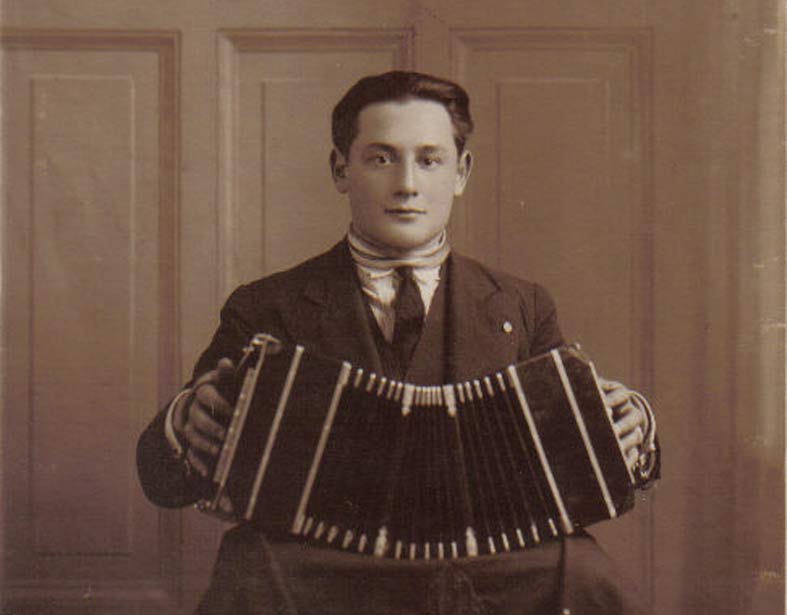 |
 |
|||||||
|
|
||||||||
| Das Bandoneon ist die Seele im Argentinischen Tango und entdecktes Instrument in der modernen Musikkultur weltweit |
The Bandoneon is the soul in Argentine Tango and discoverd instrument in modern music culture worldwide. El Bandoneón es el alma del Tango Argentino y un instrumento descubierto en la cultura musical moderna de todo el mundo. Le Bandonéon est l'âme du tango argentin et un instrument découvert dans la culture musicale moderne du monde entier. Il Bandoneon è l' anima del tango argentino e uno strumento scoperto nella moderna cultura musicale mondiale. |
| Das Bandoneon im Tango ... mehr hier |
The Bandoneon in Tango ... more here |
| Das Bandoneon in Argentinien und Uruguay | The Bandoneon in Argentina and Urugay |
| Zu Beginn des zwanzigsten Jahrhunderts entstand in Buenos Aires, dem "Paris Südamerikas", der Tango. Frühe Kompositionen sind: "Don Juan" (1898, Rosendo Mendizábal), "El choclo" (1903, Enrique Ponzio), "El porteñito" (1906, Ángel Villoldo), "La morocha" (1905, Enrique Saborido). Vielleicht entstand der Tango auch bei den Arbeitern der Hafenviertel in Montevideo (Uruguay) und Buenos Aires (Argentinien), wie es die Legenden sagen. Ganz sicher jedoch entstand er mit ausgebildeten Musikern wie Julio de Caro und dessen Brüdern, deren Eltern ein Musikkonservatorium leiteten, mit Alfredo Gobbi, Eduardo Arolas, Agustín Bardi, Roberto Firpo und vielen weiteren Musikern, Dichtern und Komponisten der sogenannten "Guardia Vieja" (alte Garde). Ab 1917 spricht man schon von der "Guardia Nueva" (neue Garde) mit der der Tango populär und verbreitet wurde. Das Bandoneon soll schon vor der Jahrhundertwende in Argentinien gewesen sein. In Verbindung mit dem Tango taucht es im ersten Jahrzehnt des zwanzigsten Jahrhunderts auf. Der Bandoneonist Vicente Greco gründete 1910 das "Orquesta Típica Criolla" (typische kreolische Orchester), was für die neue Form der Orchesterzusammensetzung von Bandoneon mit Gitarre, Flöte und Violine stand. Ab da übernahm der Klang des Bandoneons die zentrale Rolle im Tango. Die erste Aufnahme eines Bandoneon Solo war bereits 1912 die Interpretation des Tangos "La sonámbula" von Juan "Pacho" Maglio. Andere wichtige Aufnahmen des Bandoneons in dieser frühen Periode des Instruments stammen von Genaro Espósito und Vicente Loduca. Buchempfehlung: Oscar Zucchi "Tango, el Bandoneón y sus Intérpretes" ... siehe Video "La sonámbula" von Juan "Pacho" Maglio At the beginning of the twentieth century, Tango originated in Buenos Aires, the "Paris of South America". Early compositions are: "Don Juan" (1898, Rosendo Mendizábal), "El choclo" (1903, Enrique Ponzio), "El porteñito" (1906, Ángel Villoldo), "La morocha" (1905, Enrique Saborido). The tango may also have originated with the workers of the port districts of Montevideo (Uruguay) and Buenos Aires (Argentina), as legends say. It certainly originated with trained musicians such as Julio de Caro and his brothers, whose parents ran a music conservatory, with Alfredo Gobbi, Eduardo Arolas, Agustín Bardi, Roberto Firpo and many other musicians, poets and composers of the so-called "Guardia Vieja" (old guard). From 1917 onwards, people are talking about the "Guardia Nueva" (new guard) with which the tango became popular and widespread. The Bandoneon is said to have been in Argentina before the turn of the century already. In connection with the tango, it appeared in the first decade of the 20th century. The bandoneonist Vicente Greco founded the "Orquesta Típica Criolla" (Typical Creole Orchestra) in 1910, which stood for the new form of orchestral composition of Bandoneon with guitar, flute and violin. From then on, the sound of the Bandoneon took over the central role in tango. The first recording of a Bandoneon solo was as early as 1912 the interpretation of the tango "La sonámbula" by Juan "Pacho" Maglio. Other important recordings of the Bandoneon in this early period of the instrument were made by Genaro Espósito and Vicente Loduca. Book: Oscar Zucchi "Tango, el Bandoneón y sus Intérpretes" ... see video "La sonámbula" Juan "Pacho" Maglio |
 Sr. Juan Frega mit seinem neuen AA. Foto entstand ca. 1932 im Barrio de Bajo Flores, Buenos Aires / Argentinien. Sr. Juan Frega with his new Bandoneon. The picture was made around 1932 in the Barrio de Bajo Flores, Buenos Aires / Argentina  Abbildung sehr früher Modelle (aus Argentinien, Zeit unbekannt) very early models (Argentina, time unknown) |
| Das Bandoneon in Deutschland bald mehr hier |
The Bandoneon in Germany soon more here |
Heinrich Band (Krefeld 1821-1861) Heinrich Band - Foto: H.Band Museum Burg Linn Krefeld / Horst Klein |
 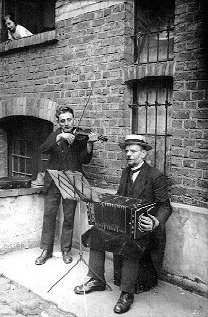 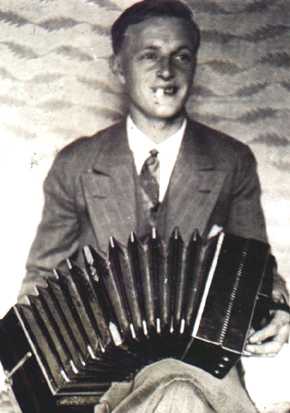 |
| Das Bandoneon in der Welt | The Bandoneon in the world |
| Mit Deutschen Auswanderern gelangte das neue Bandoneon in alle Welt. So wird es heute noch von vormals Polnischen Auswanderern auf Hochzeiten in Frankreich gespielt. Sie lernten das Bandonion im Ruhrgebiet kennen, bevor sie in den 1930er-Jahren weiter nach Frankreich auswanderten und das Bandonion mit nahmen. Das Foto rechts zeigt Alfred Radloff, Bandoneonlehrer, Komponist und ab den 1930er-Jahren Importeur von AA-Bandoneons nach Indaial in Brasilien. Deutsche Auswanderer in der Mitte des neunzehnten Jahrhunderts gründeten Städte wie Blumenau und Pomerode (Pommern) am Rio Testo in Brasilien. Tanzmusik wird dort noch heute auf großen Festen mit dem Bandoneon gespielt. In der frühen Zeit kamen 104- und 106-Tönige Instrumente nach den Siedlungen. Der Importeur für diese Bandoneons aus Deutschland, meist der Firma F. Lange, war Herr Usidell aus Blumenau. Ab den 1930er-Jahren importierte dann Alfred Radloff 142- und 152-Tönige Bandoneons der Firma Alfred Arnold. Es gibt die Geschichte, daß Alfred Radloff zwei fabrikneue Bandoneons von Alfred Arnold kostenlos bekam um den Vertrieb in Gang zu bringen. Ab den 1950er war er Vertreter für die Firma "Danielson", die in Brasilien 142-Tönige Bandoneons mit Oktavton und Rheinischer Tastatur gebaut baute. Alfred Schwabe war ein weiterer Auswanderer, der in Petropolis / Rio Grande so Sul in Brasilien lebte und AA Bandoneons nach dort importierte. The new Bandoneon reached all over the world with German emigrants. It is still played today by Polish emigrants at weddings in France. They got to know the Bandonion in the Ruhr area before they emigrated to France in the 1930s and took the Bandonion with them. The photo on the right shows Alfred Radloff, Bandoneon teacher, composer and from the 1930s importer of AA Bandoneons to Indaial in Brazil. German emigrants in the mid-nineteenth century founded cities such as Blumenau and Pomerode (Pomerania) on the Rio Testo in Brazil. Dance music is still played there today at large festivals with the Bandoneon. In the early days, 104- and 106-note instruments came to the settlements. The importer for these bandoneons from Germany, mostly from F. Lange, was Mr. Usidell from Blumenau. From the 1930s onwards, Alfred Radloff imported 142- and 152-note Bandoneons from the Alfred Arnold company. There is a story that Alfred Radloff got two brand-new Bandoneons from Alfred Arnold free of charge to get sales going. From the 1950s he was a representative for the company "Danielson", which built 142-note Bandoneons with octave tone and Rhenish keyboard in Brazil. Alfred Schwabe was another emigrant who lived in Petropolis / Rio Grande so Sul in Brazil and imported AA Bandoneons there. |
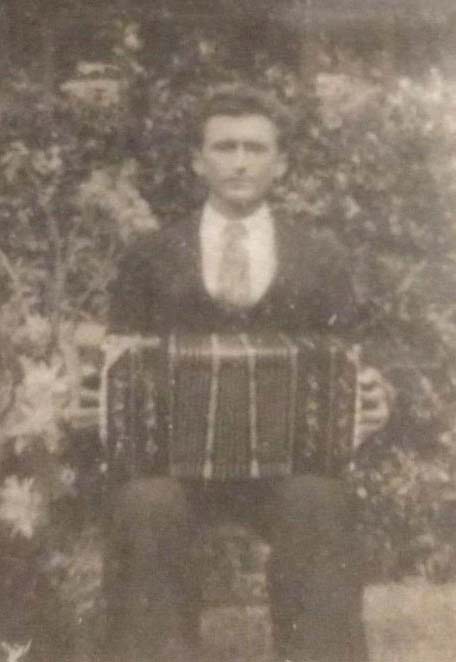 Alfred Radloff (Brasilien) Foto mit Dank an Freune in Pomerode photo with thanks to friends in Pomerode / Brazil |
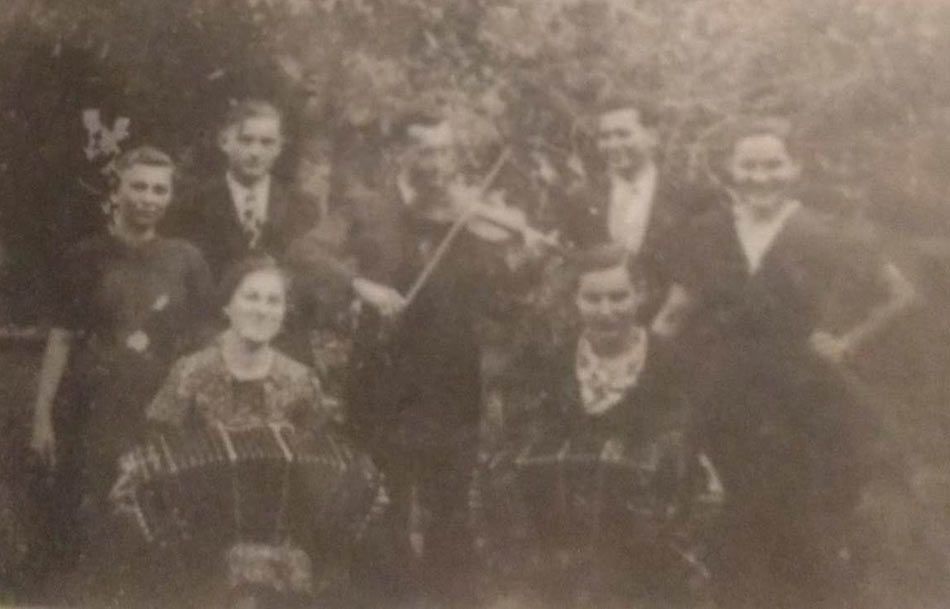 Brasilien - Foto mit Dank an Freune in Pomerode - photo with thanks to friends in Pomerode / Brazil |
|
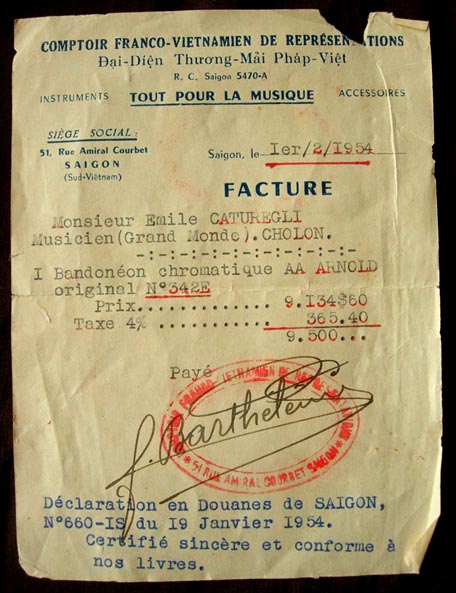 Kaufbeleg eines AA in Vietnam - receipt of an AA in Vietnam |
|
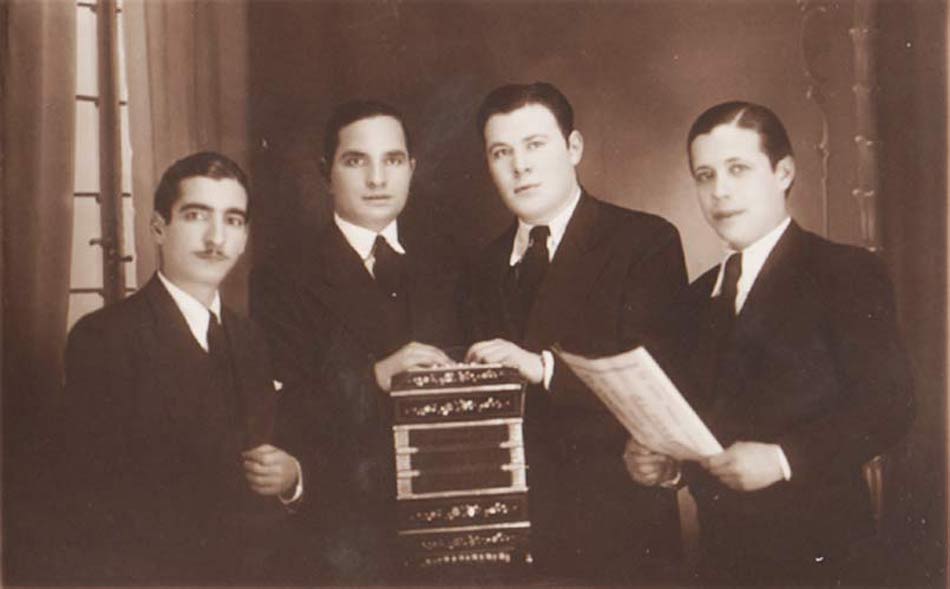 Postkartenmotiv |
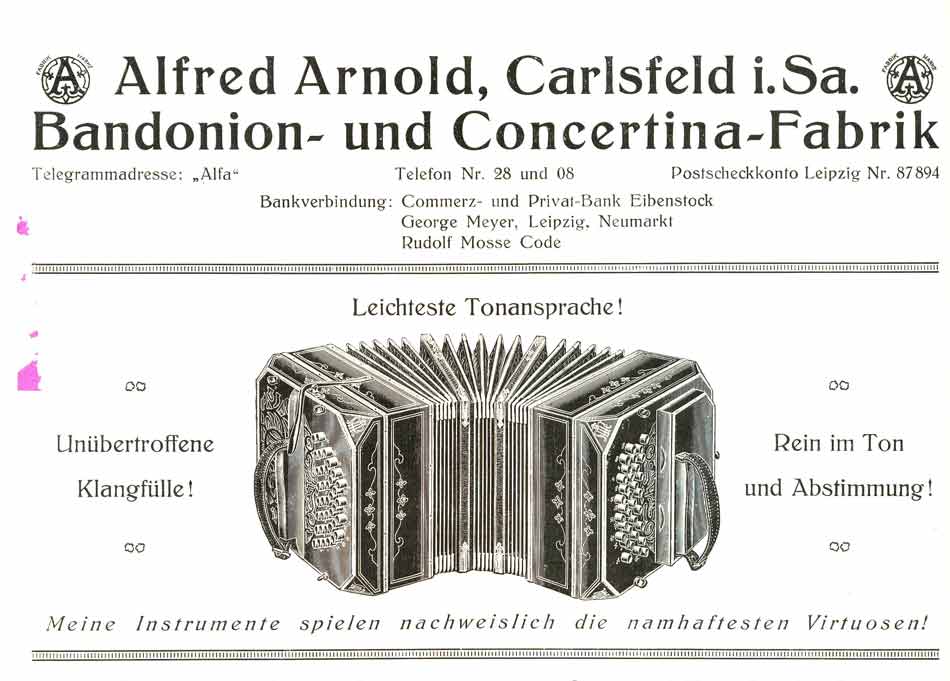 AA Katalogauszug 1937 - AA catalogue 1937 |
| © 1998-2023 BANDO BANDO Wuppertal | |
| Kontakt / Impressum Datenschutzhinweis & Hinweise zur Nutzung |
